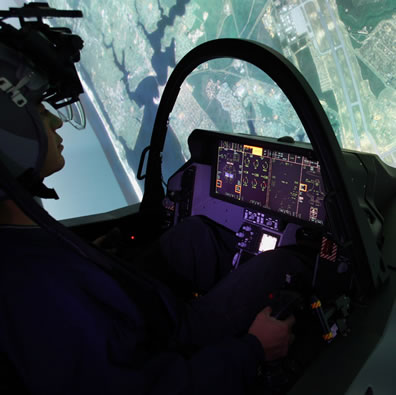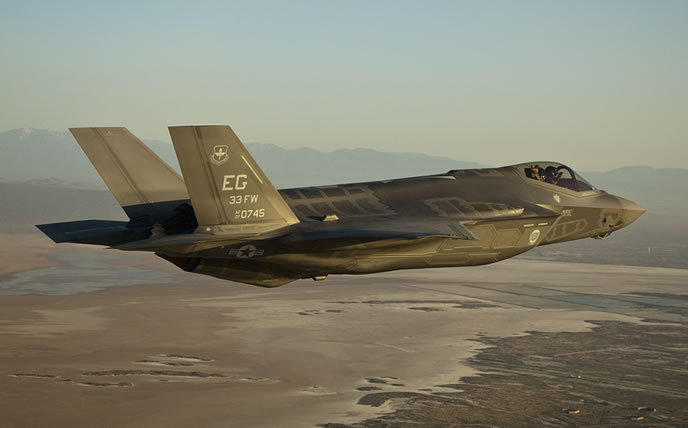
The U.S. Air Force has accepted into its fleet the first of a planned 1,763 production-model Lockheed Martin F-35 Lightning II stealth fighters. Following the official acceptance ceremony, May 5th, the F-35A jet known as ‘AF-7’ flew to Edwards Air Force Base, Calif., on Friday to begin its flight testing program. F-35s have completed more than 865 flights since flight-testing began in late 2006. In addition to AF-7, eight more production-model F-35s have rolled out and are being prepared for delivery. “This first aircraft is the beginning of the modernization of U.S. Air Force, Marine and Naval Air power and for our coalition partners around the world,” said Larry Lawson, Lockheed Martin executive vice president and F-35 program general manager. The F-35 program recorded the 300th System Development and Demonstration flight of 2011 on May 6, bringing the total number of flights for the year to 331.


Preparing for the Lightnings
At Eglin Air Force Base, preparation and assembly is underway at the base’s F-35 Integrated Training Center (ITC) for training to commence this fall. This facility will train F-35 pilots and maintainers for all partner nations and customers worldwide. On May 6, the first F-35A production aircraft destined for the Air Forces’ first operational unit at Eglin took off on its first flight. The aircraft – AF-8 will be used for pilot and maintainer training. AF-8 is the first aircraft to fly from Low Rate Initial Production lot two. Last month Lockheed Martin also delivery of the first F-35 Lightning II Full Mission Simulator (FMS) system to Eglin Air Force Base’s 33rd Fighter Wing. The simulator utilizes high-fidelity 360-degree visual display system and a reconfigurable cockpit that simulates all three aircraft variants for U.S. and international partner services.
While activity at Eglin is already beginning this year, operationally capable units are not expected to stand up before 2018. This milestone has been delayed several years from the original scheduled set after the original contract award ten years ago, as costly redesigns have slowed flight testing from the early stages, causing major delays, the latest was announced in February 2011. The recent shift has slipped the planned initial operational capability of the Air Forces’ first F-35A squadron by more than a year. With this delay, the Lightning II is also becoming more expensive. The estimated cost of the first three Low-Rate Initial Production (LRIP) lots will increase by 15 percent.
The delays are likely to affect U.S. and international customers, and reopen arguments and debates over possible alternatives. Israel, already committed to buy 20 aircraft, remains strongly supportive of the program. Last year the Israeli defense ministry allocated $2.75 billion to the acquisition of the first squadron of 20 aircraft, originally scheduled for delivery in 2016 or 2017. With the first aircraft to be delivered not earlier than 2018, the Israel Air Force and Ministry of defense remain confident the planes will become operational soon after, and the rest of the squadron’s fighters could arrive in Israel sooner than planned, as production of the aircraft will ramp up. The MOD is also hopeful that rescheduling and cost cutting measures could open new opportunities for integrating Israeli products in the aircraft. At present, only IAI and Elbit Systems are included in the F-35 program, with Elbit Systems developing the helmet display and IAI to provide Lockheed Martin with up to 900 wing sets, under a multi-year contract awarded under the industrial co-operational agreement that followed the Israeli order.
Another new development in the program was the official termination of the General Electric Rolls-Royce F-136 alternate engine for the F-35, a decision long expected, following the Pentagon’s opposition to the development of two engines for the fighters. Following the Air Forces’ announcement GE and Rolls Royce announced they will fund the program for the next 12 months, pursuing the development to the end, despite losing an important support in Congress. “Instead of being part of the problem, they have decided to be part of the solution.“ Chairman of the House Armed Services Committee, Buck McKeon, (California Rep. ) praised the team’s decision. “Instead of lobbying for the final twenty percent needed to finish the engine, the GE team has committed to funding the engine for fiscal year 12 on their own dime. I will accept and support their approach. They believe in their engine and they believe in competition. Thanks to their willingness to compromise, we’ll break up a monopoly; potentially harvest billions in savings, while fielding a more capable, more robust fighter jet – all at zero cost to the American taxpayer.”
Three distinct variants of the F-35 will replace the A-10 and F-16 for the U.S. Air Force, the F/A-18 for the U.S. Navy, the F/A-18 and AV-8B Harrier for the U.S. Marine Corps, and a variety of fighters for at least nine other countries. The world’s newest fifth generation fighter, F-35 Lightning II combines Very Low Observable stealth with high speed and agility, fully fused sensor information, network-enabled operations and reduced sustainment costs. The F-35 is capable of supersonic launch of internal weapons, including maximum-speed (Mach 1.6) launch of internal air-to-air missiles.
















